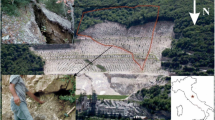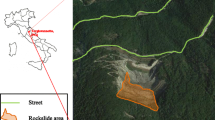Abstract
The occurrence of rockfall incidents on the transportation network may cause injuries, and even casualties, as well as severe damage to infrastructure such as dwellings, railways, road corridors, etc. Passive protective measures (i.e., rockfall barriers, wire nets, etc.) are mainly deployed by operators of ground transport networks to minimize the impact of detrimental effects on these networks. In conjunction with these passive measures, active rockfall monitoring should ideally include the magnitude of each rockfall, its initial and final position, and the triggering mechanism that might have caused its detachment from the slope. In this work, the operational principle of a low-cost rockfall monitoring and alerting system is being presented. The system integrates measurements from a multi-channel seismograph and commercial cameras as the primary equipment for event detection. A series of algorithms analyze these measurements independently in order to reduce alarms originated by surrounding noise and sources other than rockfall events. The detection methodology employs two different sets of algorithms: Time–frequency analyses of the rockfall event’s seismic signature are performed using moving window pattern recognition algorithms, whereas image processing techniques are utilized to deliver object detection and localization. Training and validation of the proposed approach was performed through field tests that involved manually induced rockfall events and recording of sources (i.e., passing car, walking people) that may cause a false alarm. These validation tests revealed that the seismic monitoring algorithms produce a 4.17 % false alarm rate with an accuracy of 93 %. Finally, the results of a 34-day operational monitoring period are presented and the ability of the imaging system to identify and exclude false alarms is discussed. The entire processing cycle is 10–15 s. Thus, it can be considered as a near real-time system for early warning of rockfall events.















Similar content being viewed by others
References
AgilFence, AgilFence: perimeter intrusion detection system. http://www.agilsense.com/useruploads/files/agilfencepids-productbrochurepdf.pdf. ccessed 4 April 2016
Agioutantis Z, Mertikas S, Steiakakis C, Daskalakis A, Tripolitsiotis A, Krtitikakis G, Apostolou E, Kaplanidis G (2014) Rockfall monitoring system for improving road safety. In: Alejano R, Perucho Á, Olalla C, Jiménez R (eds) Rock engineering and rock mechanics: Structures in and on rock masses. CRC Press, Taylor & Francis Group, pp 965–970. doi:10.1201/b16955-166
Arosio D, Longoni L, Papini M, Scaioni M, Zanzi I, Alba M (2009) Towards rockfall forecasting through observing deformation and listening to microseismic emissions. Nat Hazards Earth Syst Sci 9:1119–1131
Baillard C, Crawford WC, Ballu V, Hibert C, Mangeney A (2014) An automatic kurtosis-based P- and S-phase picker designed for local seismic networks. Bull Seism Soc Am. doi:10.1785/0120120347
Below R, Wirtz A, Guha-Sapir D (2009) Working paper: Disaster category classification and peril terminology for operational purposes, centre for research on the epidemiology of disasters. http://cred.be/sites/default/files/DisCatClass_264.pdf. Accessed 27 June 2016
Carrea D, Abellan A, Chantry R, Pedrazzini A, Jaboyedoff M (2013) Monitoring rockfall failure deformation in an active quarry Switzerland. In: Geophysical research abstracts, vol 15, EGU2013-11247, EGU General Assembly. Available online at: http://meetingorganizer.copernicus.org/EGU2013/EGU2013-11247.pdf
Collins D-S, Toya Y, Hosseini Z, Trifu C-I (2014) Real time detection of rock fall events using a microseismic railway monitoring system. In: GeoHazards 6, Kingston, Canada. Available on line at: https://www.esgsolutions.com/sites/esgsolutions.com/files/resource/2014_geohazards_-_railway_monitoring.pdf
Coviello V, Arattano M, Turconi L (2015) Detecting torrential processes from a distance with a seismic monitoring network. Nat Hazards 78:2055–2080. doi:10.1007/s11069-015-1819-2
Economou N, Kritikakis G, Tripolitsiotis A, Partsinevelos P, Vlachou G, Agioutantis A, Vafidis A (2015) Seismic monitoring for automatic rockfall detection along transportation corridor. European Association of Geoscientists and Engineers, 8th Congress of the Balkan Geophysical Society, doi: 10.3997/2214-4609.201414214
Fawcett T (2006) An introduction to ROC analysis. Pattern Recogn Lett 27:861–874. doi:10.1016/j.patrec.2005.10.010
Flash P (2003) The Geometry of ROC space: understanding machine learning metrics through ROC isometrics. In: Proceedings of the twentieth international conference on machine learning (ICML-2003). Washington, pp 226–233
Gholamy S, Javaherian A, Ghods A (2008) Automatic detection of interfering seismic wavelets using fractal methods. J Geophys Eng 5:338–347
Hand DJ (2009) Measuring classifier performance: a coherent alternative to the area under the ROC curve. Mach Learn 77:103–123. doi:10.1007/s10994-009-5119-5
Helmstetter A, Garambois S (2010) Seismic monitoring of Sechilienne Rockslide (French Alps): analysis of seismic signals and their correlation with rainfalls. J Geophys Res 115(F3):F03016
Hibert C, Mangency A, Grandjean G, Shapiro M-N (2011) Slope instabilities in Dolomieu crater, Reunion Island: from seismic signals to rockfall characteristics. J Geophys Res 116:F04032
Hibert C, Mangeney A, Grandjean G, Bailard C, Rivet D, Shapiro N-M, Satriano C, Maggi A, Boisser P, Ferrazzini V, Crawford W (2014) Automated identification, location, and volume estimation of rockfalls at Piton de la Fournaise volcano. J Geophys Res Earth Surf 119(5):1082–1105
Impact Sentinel, Impact Sentinel: Remote monitoring of GEOBRUGG-rockfall protection systems. http://www.impact-sentinel.com/Impact_Sentinel_Broschure_en.pdf. Accessed 2 April 2016
Iwasaki T (2002) Extended time-term method for identifying lateral structural variations from seismic refraction data. Earth Planets Space 54:663–677
Joyce K-E, Samsonov S-V, Levick S-R, Engelbrecht J, Belliss S (2014) Mapping and monitoring geological hazards using optical, LiDAR, and synthetic aperture RADAR image data. Nat Hazards 73:137–163
Kromer R, Hutchinson J, Lato M, Gauthier D, Edqards T (2015) Predicting rockfall occurrence remotely in an operational rail corridor. In: Geophysical research abstracts, vol 17, EGU2015-8237. EGU General Assembly. Available online at: http://meetingorganizer.copernicus.org/EGU2015/EGU2015-8237.pdf
Levy C, Jongmans D, Baillet L (2011) Analysis of seismic signals recorded on a prone-to-fall rock column (Vercors massif, French Alps). Geophys J Int 186:296–310
Park CB, Miller RD, Xia J (1999) Multichannel analysis of surface waves. Geophysics 64(3):800–808. doi:10.1190/1.1444590
Partsinevelos P, Mertikas S, Agioutantis Z, Tsioukas V, Tripolitsiotis A, Zervos P (2014) Rockfall detection along road networks using close range photogrammetry. In: Proceedings of SPIE 9229, second international conference on remote sensing and geoinformation of the environment (RSCy2014), 92291 M (12 August 2014); doi: 10.1117/12.2068787
Partsinevelos P, Kallimani C, Tripolitsiotis A (2015) Multi-temporal change image inference towards false alarms reduction for an operational photogrammetric rockfall detection system. In: Proceedings of SPIE 9535, third international conference on remote sensing and geoinformation of the environment (RSCy2015), 95351R (June 19, 2015); doi:10.1117/12.2199736
Powers MWD (2011) Evaluation: from precision, recall and F-factor to ROC, informedness, markedness and correlation. J Mach Learn Technol 2(1):37–63
Rydelek P, Pujol J (2004) Real-time seismic warning with a two-station subarray. Bull Seismol Soc Am 94(4):1546–1550
Sättele M, Bründl M, Straub D (2015) Reliability and effectiveness of early warning systems for natural hazards: concept and application to debris flow warning. Reliab Eng Syst Saf 142(2015):192–202. doi:10.1016/j.ress.2015.05.003
Schenato L, Palmieri L, Gruca G, Iannuzzi D, Marcato G, Pasuto A, Galtarossa A (2012) Fiber optic sensors for precursory acoustic signals detection in rockfall events. J Eur Opt Soc Rapid Publ 7:12048. doi:10.2971/jeos.2012.12048
Tripolitsiotis A, Daskalakis A, Mertikas S, Hristopulos D, Agioutantis Z, Partsinevelos P (2015) Detection of small-scale rockfall incidents using their seismic signature. In: Proceedings of SPIE 9535, third international conference on remote sensing and geoinformation of the environment (RSCy2015), 953519 (19 June 2015); doi: 10.1117/12.2192591
Trnkoczy A (2002) Understanding and parameter setting of STA/LTA trigger algorithm. In: Bormann P (ed) IASPEI new manual of seismological observatory practice (NMSOP), vol 2. Deutsches GeoForschungsZentrum, Potsdam, p 119
Turcotte D, Abaimov S, Shcherbakov R, Rundle J (2007) Nonlinear dynamics of natural hazards. In: Tsonis AA, Elsner JB (eds) Nonlinear dynamics in geosciences. Springer, New York, pp 557–580
Vilajosana I, Surinach E, Abellan A, Khazaradze G, Garcia D, Llosa J (2008) Rockfall induced seismic signals: case study in Montserrat Catalonia. Nat Hazards Earth Syst Sci 8:805–812
Weir-Jones Engineering Consultants Ltd (2015) System and method for detecting rockfall, Patent No.: US2015285927 (A1). European Patent Office. Accessed: 14 Nov 2015
Wieczorek G-F, Snyder J-B (2009) Monitoring slope movements. In: Young R, Norby L (eds) Geological monitoring. Geological Society of America, Boulder, pp 245–271. doi:10.1130/2009.monitoring(11)
Withers M, Aster R, Young C, Beiriger J, Harris M, Moore S, Trujillo J (1998) A comparison of select trigger algorithms for automated global seismic phase and event detection. Bull Seism Soc Am 88:95–106
Zhang J, Toksozf N-M (1998) Nonlinear refraction traveltime tomography. Geophysics 63(5):1726–1737
Acknowledgments
Part of this work has been performed under the framework of the “Cooperation 2011” project ISTRIA (11_SYN_9_1389) funded from the Operational Program “Competitiveness and Entrepreneurship” (co-funded by the European Regional Development Fund (ERDF)) and managed by the Greek General Secretariat for Research and Technology. The authors would also like to acknowledge the support provided by the Chania Municipality for the concession of the infrastructure for instrument housing, Dr. A. Daskalakis for developing the modified moving window triggering algorithm, Ms. Vlachou for developing the data management system and Ms. Kobitsaki for her assistance during field experiments.
Author information
Authors and Affiliations
Corresponding author
Rights and permissions
About this article
Cite this article
Partsinevelos, P., Kritikakis, G., Economou, N. et al. Integration of seismic and image data processing for rockfall monitoring and early warning along transportation networks. Nat Hazards 83 (Suppl 1), 133–153 (2016). https://doi.org/10.1007/s11069-016-2462-2
Received:
Accepted:
Published:
Issue Date:
DOI: https://doi.org/10.1007/s11069-016-2462-2




